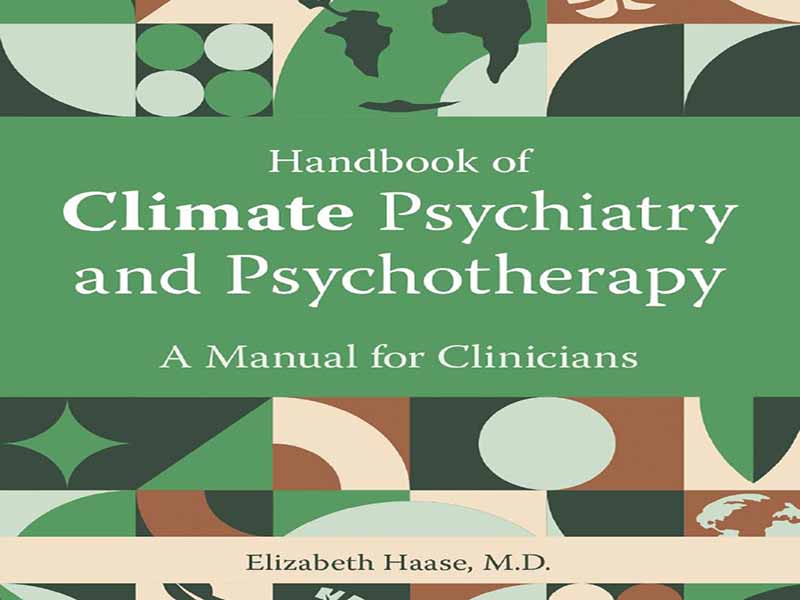- عنوان کتاب: Handbook of Climate Psychiatry and Psychotherapy
- نویسنده: Elizabeth Haase
- حوزه: رواندرمانی
- سال انتشار: 2025
- تعداد صفحه: 361
- زبان اصلی: انگلیسی
- نوع فایل: pdf
- حجم فایل: 4.62 مگابایت
بحران آب و هوا به سرعت در حال بیثبات کردن سیستمهای پایدار حیات در سراسر جهان است. در عین حال، پیشرفت در جهت کاهش انتشار گازهای گلخانهای به دلیل درگیریها و انفعال سیاسی، اینرسی وابسته به فرهنگ و نیازهای جهانی انرژی، هم در حال پیشرفت و هم به طور قابل توجهی متزلزل است. صدها میلیون نفر در حال حاضر از گرمای شدید و آب و هوای نامساعد (لی و همکاران، 2020) و پیامدهای اجتماعی-اقتصادی و بهداشتی مرتبط با آنها رنج میبرند. آسیب به اکوسیستمها به طور گسترده قابل مشاهده شده است و اکثر آمریکاییها از این اثرات ابراز ناراحتی میکنند (انجمن روانپزشکی آمریکا، 2020). فراخوان آشکاری برای گذار از آنتروپوسن، دوره و شیوه زندگی سازمانیافته پیرامون منابع انرژی مبتنی بر سوختهای فسیلی و بهرهبرداری از منابع طبیعی، به همزیستی وجود دارد، که در آن انسانها در روابط مراقبتی متقابل (همزیستی) با گونهها و منابعی که برای زندگی به آنها وابسته هستند، رشد میکنند. عناصر اصلی گرمایش جهانی بر زیستشناسی عصبی، علائم روانی و اپیدمیولوژی روانی در سطوح آماری و بالینی مرتبط از طریق آلودگی هوا، گرمای شدید و تغییرات در منابع غذایی و بیماریهای عفونی تأثیر میگذارند. آگاهی از تأثیرات عصبی-روانی این روندهای جهانی، خارج از ادبیات سلامت روان پدیدار شده و بنابراین در جامعه روانپزشکی فعال، به اندازه کافی مورد توجه قرار نگرفته است. پریشانی مرتبط با آب و هوا، از جمله اضطراب اکولوژیکی، غم و اندوه و خشم، اکثر مردم و بنابراین اکثر کسانی را که به دنبال مراقبتهای سلامت روان هستند، تحت تأثیر قرار میدهد، اما سیستمها و رویههای روانپزشکی برای پشتیبانی از تشخیص و درمان بالینی وجود ندارد. آگاهی از این پریشانی تا شش سال گذشته، عمدتاً در رسانهها و جنبشهای زیستمحیطی پدیدار شده است، زمانی که پزشکان در حوزههای مرتبط با سلامت روان شروع به افشای آن و بررسی نحوه مداخله کردند. به موقع و ضروری است که روانپزشکان و سایر متخصصان سلامت روان اطلاعات کافی برای پرداختن به جنبههای بالینی این اثرات اقلیمی در عمل خود داشته باشند. این کتاب به این دلیل نوشته شده است که اگرچه بسیاری از کتابها مدیریت اثرات روانی تغییرات اقلیمی را پوشش میدهند، اما بیشتر آنها به خواننده غیرمتخصص گرایش دارند. نمونههایی از این کتابها عبارتند از: راهنمای میدانی برای اضطراب اقلیمی (ری ۲۰۲۰)، تابآوری عاطفی در عصر تغییرات اقلیمی (داونپورت ۲۰۱۷)، تغییر مسیر اضطراب اقلیمی: اقدام پایدار برای سلامت روان و سیاره زمین (کندی-وودارد و کندی- ویلیامز ۲۰۲۲)، تحمل گرما: چگونه تغییرات اقلیمی بر ذهن، بدن و روح شما تأثیر میگذارد و چه کاری میتوانید در مورد آن انجام دهید (اشنایدر ۲۰۲۲)، راهنمای اضطراب زیستمحیطی: چگونه از سیاره و سلامت روان خود محافظت کنیم (گروس ۲۰۲۰) و ترس نسلی: یافتن هدف در عصر بحران اقلیمی (ری ۲۰۲۳). برخی دیگر، که به بررسی درمانهای مبتنی بر طبیعت میپردازند، به درمانگران گرایش دارند، از جمله اکوتراپی: شفای خودمان، شفای زمین: راهنمایی برای نظریه شخصیت، معنویت، درمان و آموزش مبتنی بر بومشناسی (کلاینبل ۱۹۹۶)، طبیعت و درمان: درک مشاوره و رواندرمانی در فضاهای باز (جردن ۲۰۱۴)، درمان وحشی: احیای دنیای درونی و بیرونی ما (تاتون ۲۰۲۱) و به سوی یک اکوسایکوتراپی (راست ۲۰۲۰). از جمله کتابهای مناسب برای متخصصان میتوان به «تغییرات اقلیمی و رفاه انسان» (وایسبکر ۲۰۱۱)، «تغییرات اقلیمی جهانی و سلامت انسان: از علم تا عمل» (لوبر و لمری ۲۰۱۵)، «روانشناسی و تغییرات اقلیمی: ادراکات، تأثیرات و پاسخهای انسانی» (کلیتون و منینگ ۲۰۱۸)، «بحران اقلیمی، روانکاوی و اخلاق رادیکال» (اورنج ۲۰۱۷)، «تغییرات اقلیمی و سلامت روان جوانان» (هاسه و هادسون ۲۰۲۴)، «درگیر شدن با تغییرات اقلیمی: دیدگاههای روانکاوانه و میانرشتهای» (وینتروب ۲۰۱۳) و «ریشههای روانشناختی بحران اقلیمی: استثناگرایی نئولیبرال و فرهنگ بیتوجهی» (وینتروب ۲۰۲۱) اشاره کرد. کتابهای بسیار دیگری اخیراً منتشر شدهاند یا در دست تدوین هستند و به منابع بسیار خوبی تبدیل خواهند شد. با وجود غنای این ادبیات، هیچ یک از این آثار برای پرداختن به کار روزمرهای که روانپزشکان در مطبها، مؤسسات و جوامع خود انجام میدهند، تنظیم نشدهاند. بنابراین هدف این کتاب، ارائه طیف وسیعی از مسائل ذاتی در پاسخ روانپزشکی و روانشناختی به تغییرات اقلیمی در قالبی است که برای متخصصان سلامت روان مستقر در مطب یا کلینیک، از جمله پزشکان، دستیاران پزشک، پرستاران و متخصصان سلامت روان مرتبط، قابل دسترسی باشد. برای اطمینان از کاربردپذیری در روزهای شلوغ بالینی، نگارش نسبتاً غیررسمی، اغلب قالببندی شده یا بولتگذاری شده است، به این امید که زیرعنوانهای واضح، جداول متعدد، شرح حالهای موردی و قالببندی ثابت در بین فصلها به خواننده این امکان را بدهد که به راحتی یک تجربه مرتبط با آب و هوا را که توسط بیمار شناسایی شده است، پیدا و برچسبگذاری کند و به سرعت در مورد روشهای مختلف درک و پاسخ به نیاز بیمار مطالعه کند. این کتاب به چهار بخش تقسیم شده است. بخش اول شامل این مقدمه و فصلهایی است که جهتگیری در مورد عدالت اقلیمی را ارائه میدهند…
The climate crisis is rapidly destabilizing life-sustaining systems around the globe. At the same time, progress to lower greenhouse gas emissions is both advancing and significantly faltering because of political conflict and inaction, culturally bound inertia, and global energy needs. Hundreds of millions of people are already suffering from extreme heat and extreme weather (Li et al. 2020) and their associated socioeconomic and health consequences. The damage to ecosystems has become broadly visible, and the majority of Americans are expressing distress about these effects (American Psychiatric Association 2020). There is a clarion call to move from the Anthropocene, an era and way of life organized around fossil fuel– based sources of energy and exploitation of natural resources, to the Symbiocene, in which humans thrive in mutually caretaking (symbiotic) relationships with those species and resources on which they depend for life. Core elements of global warming affect neurobiology, psychiatric symptoms, and psychiatric epidemiology at statistically and clinically relevant levels through air pollution, extreme heat, and changes to food supplies and infectious diseases. Knowledge of the neuropsychiatric impacts of these global trends has emerged outside the mental health literature and is thus underappreciated within the practicing psychiatric community. Climate-related distress, including ecological anxiety, grief, and rage, is affecting most people and therefore also most of those who seek mental health care, but psychiatric systems and procedures are not in place to support clinical recognition and treatment. Awareness of this distress has emerged mostly in the media and environmental movement until the last half-dozen years, when clinicians across the allied mental health fields began to call it out and consider how to intervene. It is timely and imperative that psychiatrists and other mental health professionals have adequate information to address the clinical aspects of these climate effects in their practice. This book was conceived because, although many books cover management of the psychological effects of climate change, most are oriented toward the lay reader. Examples include A Field Guide to Climate Anxiety (Ray 2020), Emotional Resiliency in the Era of Climate Change (Davenport 2017), Turn the Tide on Climate Anxiety: Sustainable Action for Your Mental Health and the Planet (Kennedy-Woodard and Kennedy- Williams 2022), Taking the Heat: How Climate Change Is Affecting Your Mind, Body, and Spirit and What You Can Do About It (Schneider 2022), A Guide to Eco-Anxiety: How to Protect the Planet and Your Mental Health (Grose 2020), and Generation Dread: Finding Purpose in an Age of Climate Crisis (Wray 2023). Others, exploring nature-based therapies, are oriented toward therapists, including Ecotherapy: Healing Ourselves, Healing the Earth: A Guide to Ecologically Grounded Personality Theory, Spirituality, Therapy, and Education (Clinebell 1996), Nature and Therapy: Understanding Counselling and Psychotherapy in Outdoor Spaces (Jordan 2014), Wild Therapy: Rewilding Our Inner and Outer Worlds (Totton 2021), and Towards an Ecopsychotherapy (Rust 2020). Among books for professionals are Climate Change and Human Well- Being (Weissbecker 2011), Global Climate Change and Human Health: From Science to Practice (Luber and Lemery 2015), Psychology and Climate Change: Human Perceptions, Impacts, and Responses (Clayton and Manning 2018), Climate Crisis, Psychoanalysis, and Radical Ethics (Orange 2017), Climate Change and Youth Mental Health (Haase and Hudson 2024), Engaging With Climate Change: Psychoanalytic and Interdisciplinary Perspectives (Weintrobe 2013), and Psychological Roots of the Climate Crisis: Neoliberal Exceptionalism and the Culture of Uncare (Weintrobe 2021). Many more books have been published recently or are in development and will become excellent resources. Despite the richness of this literature, none of these works has been tailored to address the day-to-day work that psychiatrists do in their offices, institutions, and communities. The goal of this book is therefore to lay out the range of issues inherent in the psychiatric and psychological response to climate change in a format that is accessible to office-based or clinic-based mental health clinicians, including physicians, physician assistants, nurse practitioners, and allied mental health professionals. To ensure utility on busy clinical days, the writing has been kept relatively informal, often formatted or bulleted, in hopes that clear subheadings, multiple tables, case vignettes, and a consistent format across chapters will allow the reader to easily find and label a climate-related experience identified by a patient and quickly read about various ways to understand and respond to the patient’s need. This book is divided into four parts. Part I includes this introduction and chapters providing an orientation to climate justice and the ethics, advocacy, and activism of engaging with climate change as a psychiatrist. Part II provides a review of the neurobiological impacts of climate effects on the brain. Part III includes chapters on how to perform a climate-informed patient assessment and make practical and psychotherapeutic interventions for climate adaptation and distress at the individual and group levels. Part IV provides discussion of the community, global, institutional, research, and educational aspects of climate psychiatry. The book also includes an appendix with some of the rapidly evolving resources for climate mental health and climate-related community involvement for both young people and adults.
این کتاب را میتوانید از لینک زیر بصورت رایگان دانلود کنید:



































نظرات کاربران